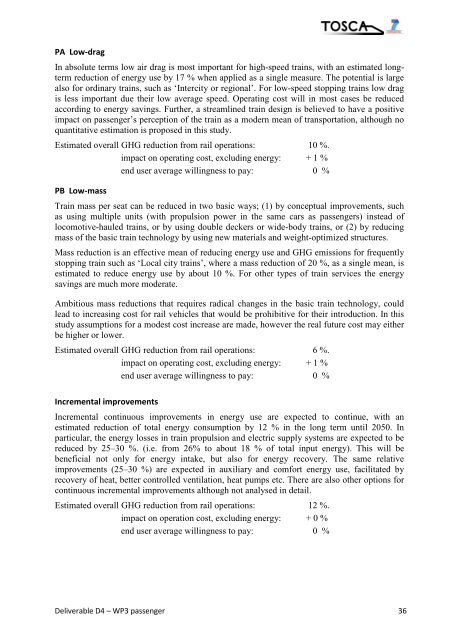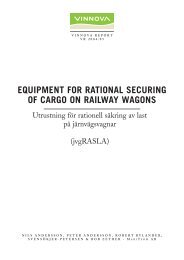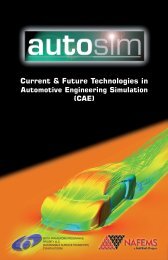WP3: Rail Passenger Transport - TOSCA Project
WP3: Rail Passenger Transport - TOSCA Project
WP3: Rail Passenger Transport - TOSCA Project
Create successful ePaper yourself
Turn your PDF publications into a flip-book with our unique Google optimized e-Paper software.
PA Low-drag<br />
In absolute terms low air drag is most important for high-speed trains, with an estimated longterm<br />
reduction of energy use by 17 % when applied as a single measure. The potential is large<br />
also for ordinary trains, such as ‘Intercity or regional’. For low-speed stopping trains low drag<br />
is less important due their low average speed. Operating cost will in most cases be reduced<br />
according to energy savings. Further, a streamlined train design is believed to have a positive<br />
impact on passenger’s perception of the train as a modern mean of transportation, although no<br />
quantitative estimation is proposed in this study.<br />
Estimated overall GHG reduction from rail operations: 10 %.<br />
impact on operating cost, excluding energy: + 1 %<br />
end user average willingness to pay: 0 %<br />
PB Low-mass<br />
Train mass per seat can be reduced in two basic ways; (1) by conceptual improvements, such<br />
as using multiple units (with propulsion power in the same cars as passengers) instead of<br />
locomotive-hauled trains, or by using double deckers or wide-body trains, or (2) by reducing<br />
mass of the basic train technology by using new materials and weight-optimized structures.<br />
Mass reduction is an effective mean of reducing energy use and GHG emissions for frequently<br />
stopping train such as ‘Local city trains’, where a mass reduction of 20 %, as a single mean, is<br />
estimated to reduce energy use by about 10 %. For other types of train services the energy<br />
savings are much more moderate.<br />
Ambitious mass reductions that requires radical changes in the basic train technology, could<br />
lead to increasing cost for rail vehicles that would be prohibitive for their introduction. In this<br />
study assumptions for a modest cost increase are made, however the real future cost may either<br />
be higher or lower.<br />
Estimated overall GHG reduction from rail operations: 6 %.<br />
impact on operating cost, excluding energy: + 1 %<br />
end user average willingness to pay: 0 %<br />
Incremental improvements<br />
Incremental continuous improvements in energy use are expected to continue, with an<br />
estimated reduction of total energy consumption by 12 % in the long term until 2050. In<br />
particular, the energy losses in train propulsion and electric supply systems are expected to be<br />
reduced by 25–30 %. (i.e. from 26% to about 18 % of total input energy). This will be<br />
beneficial not only for energy intake, but also for energy recovery. The same relative<br />
improvements (25–30 %) are expected in auxiliary and comfort energy use, facilitated by<br />
recovery of heat, better controlled ventilation, heat pumps etc. There are also other options for<br />
continuous incremental improvements although not analysed in detail.<br />
Estimated overall GHG reduction from rail operations: 12 %.<br />
impact on operation cost, excluding energy: + 0 %<br />
end user average willingness to pay: 0 %<br />
Deliverable D4 – <strong>WP3</strong> passenger 36
















